The acquisition of kindness emerges as a vital proficiency, assuming a paramount role due to its capacity to craft a favorable initial encounter and to manifest one’s emotional acumen. Its utility spans both individual and occupational milieus, operating as a conduit for communicating genuine concern for others in their entirety, rather than just instrumental objectives. Nonetheless, the cultivation of kindness demands deliberate instruction and observation, as opposed to an intrinsic proclivity.
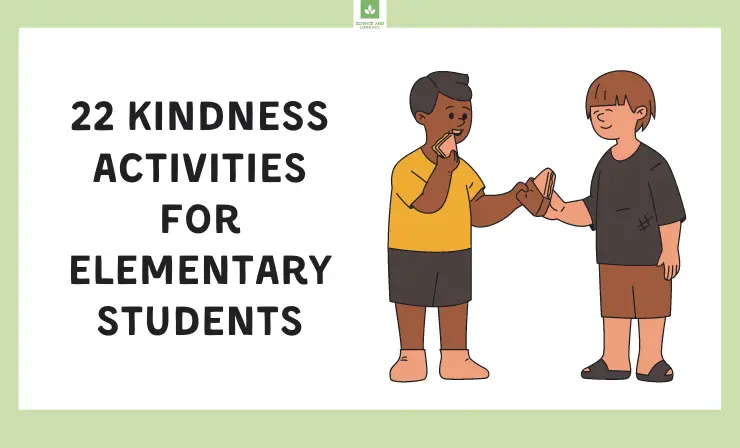
Educators evince an affinity for imparting lessons in kindness through a spectrum of diverse undertakings:
What a wonderful way to wrap up a school year! 🎉
By decorating sleeves for their local coffee shop, 3rd and 4th graders learned to spread some kindness in their community, writes elementary school counselor Ms. Benitez. 🌈 ❤️ pic.twitter.com/RMdBLDIYdz
— edutopia (@edutopia) June 11, 2023
Outlined below are several student-oriented activities that offer effective avenues for initiating the practice of fostering compassion and commencing explorations into socio-emotional growth within the elementary classroom context.
So, the 22 kindness activities for elementary students I’ve chosen are:
| Kindness activity | Difficulty level | Cost | What does it teach |
| 1. Clothespins | Low | Low | Organization and collaboration; hanging kind messages or achievements. |
| 2. Kindness Calendar | Low | Low | Consistency, empathy, and planning; performing daily acts of kindness. |
| 3. Paper Chain | Low | Low | Sequential thinking, cooperation, and visual representation; adding a link for each act of kindness. |
| 4. Compliment Box | Low | Low | Observational skills, positivity, and self-esteem; sharing compliments and kind words. |
| 5. Kindness Jar | Low | Low | Gratitude, recognition, and intentionality; collecting and reading acts of kindness. |
| 6. Tic-Tac-Toe | Low | Low | Strategy, sportsmanship, and decision-making; playing a kindness-themed game. |
| 7. Fortune Teller | Low | Low | Creativity, engagement, and communication; generating kind messages in an interactive format. |
| 8. Kindness Stones | Low | Medium | Creativity, mindfulness, and generosity; painting or sharing decorated stones with kind words. |
| 9. Kindness Gift | Low | Medium | Creativity, thoughtfulness, and giving; crafting or giving tokens of kindness. |
| 10. Kindness Oath | Low | Low | Commitment, responsibility, and values; pledging to engage in acts of kindness. |
| 11. Kindness Break | Low | Free | Mindfulness, self-care, and stress reduction; taking a short break for self-kindness. |
| 12. Class Brainstorm | Low | Free | Collaboration, communication, and inclusivity; generating and sharing kindness ideas. |
| 13. Friendly Fridays | Low | Free | Routine, community-building, and consistency; designating a day for extra kindness. |
| 14. Kindness from A to Z | Low | Low | Creativity, vocabulary, and exploration; associating kindness with different letters. |
| 15. Be Kind to Yourself | Medium | Free | Self-awareness, self-compassion, and well-being; focusing on self-kindness. |
| 16. Kindness Quilt | Medium | Medium | Creativity, teamwork, and symbolism; contributing to a visual representation of kindness. |
| 17. Science of Kindness | Medium | Free | Critical thinking, exploration, and empathy; understanding the psychological and physiological effects of kindness. |
| 18. Kindness Videos | Medium | Free | Empathy, and communication; watching and discussing videos on kindness. |
| 19. Wheel of Kindness | High | Medium | Engagement, decision-making, and spontaneity; spinning a wheel to determine a kind action. |
| 20. Dance for Kindness | Medium | Free | Expression, unity, and community involvement; dancing together for a common cause. |
| 21. Ripple Effect | High | Medium | Causality, interconnectedness, and empathy; understanding how small acts of kindness can create positive impacts. |
| 22. Edgar the Egg | High | Medium | Engagement, creativity, and empathy; caring for a “fragile” character to learn about kindness. |
And now let’s talk about each in details.
1. Clothespins
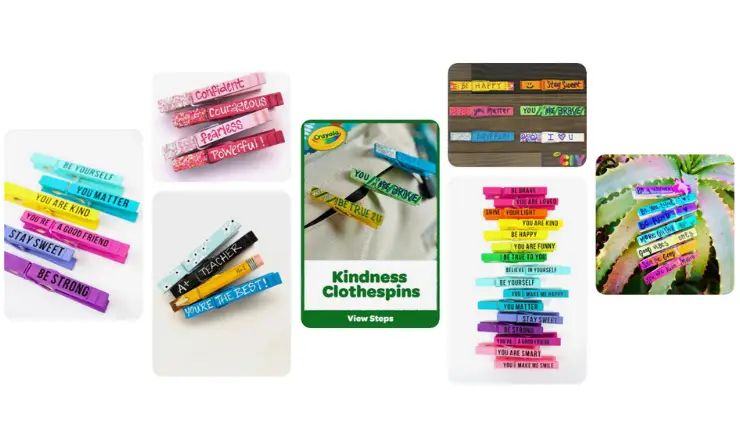
Difficulty level: Low
Cost: Low
What Does It Teach: Organization and collaboration; hanging kind messages or achievements.
In this endeavor, students undertake the role of covert agents engaged in clandestine missions, tasked with identifying instances of kindness and positive attributes in their surroundings. Deliberations ensue, wherein students articulate affirmative characteristics they aspire to witness in fellow individuals. Subsequently, they inscribe these traits onto clothespins and proceed to affix them onto their peers who exemplify said qualities, effectuating an unobtrusive acknowledgment.
Through this covert observation, students exercise discernment and cognition, subtly acknowledging and reinforcing commendable attributes within their community. The deliberative phase, wherein traits are distilled, facilitates the refinement of value-based discernment. The physical act of attaching clothespins to exemplars of the identified traits nurtures a sense of recognition and camaraderie, whilst reinforcing collective positivity without direct proclamation. This mechanism cultivates an atmosphere wherein virtuous attributes become the fabric of daily interactions, fostering an ethos of mutual respect and amiable association.
Here’s a video showcasing creative ways to utilize clothespins in fostering kindness:
2. Kindness Calendar
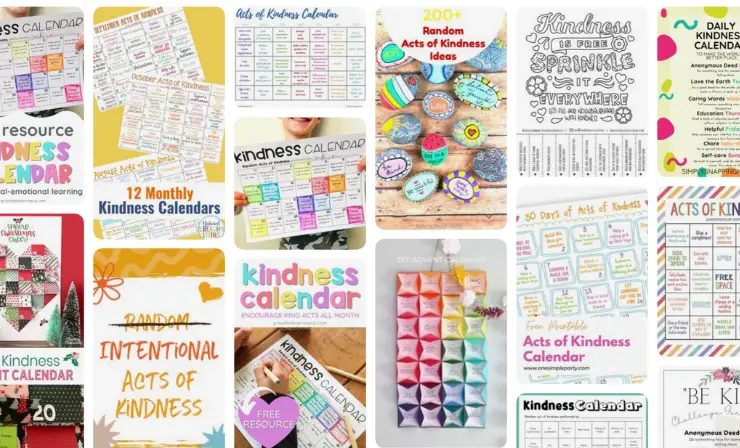
Difficulty level: Low
Cost: Low
What Does It Teach: Consistency, empathy, and planning; performing daily acts of kindness.
Initiate each class day by offering students an occasion to extend kindness towards their peers, thereby instilling a milieu characterized by benevolence. A calendar dedicated to this purpose encapsulates a myriad of recommendations, delineating avenues through which students can actively express kindness in their quotidian interactions. This practice consequently assumes significance as it integrates into the fabric of their existence, fostering an ethos where kindness becomes an integral aspect of their daily lives.
Discover a video guide on implementing a Kindness Calendar for meaningful engagement:
3. Paper Chain
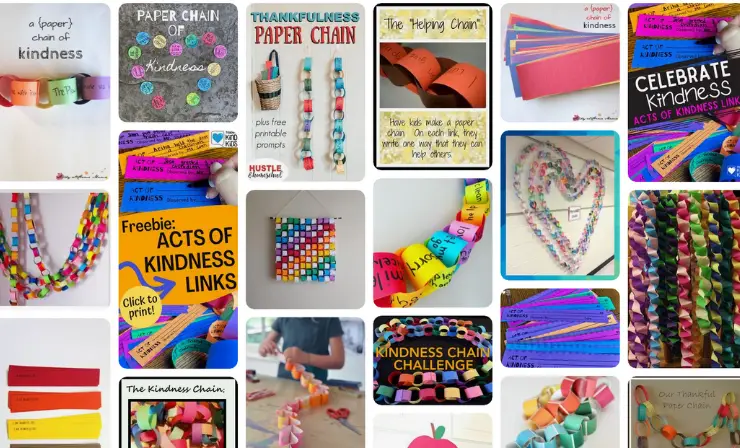
Difficulty level: Low
Cost: Low
What Does It Teach: Sequential thinking, cooperation, and visual representation; adding a link for each act of kindness.
Foster a dual achievement by generating a classroom embellishment while propagating kindness. Pupils partake in a process involving inscribing considerate notions onto paper strips. Subsequently, these articulated ideas are presented before the class audience. A subsequent action involves the assemblage of a paper chain, formed by the interlinking of these strips, to be suspended within the classroom space. The synergy of this endeavor lies in its amalgamation of creativity with the cultivation of empathetic behavior.
Through this process, students cultivate cognitive engagement, entailing the reflection upon and formulation of kind actions. The communal reading phase broadens the discourse, endorsing the exchange of these notions within the collective realm. The manifestation of these reflections as a paper chain introduces a visual and symbolic dimension, a manifestation of accumulated goodwill. Thus, this endeavor resonates as an embodiment of both artistic creation and ethical elevation, nurturing an environment wherein the concept and practice of kindness harmoniously coexist.
Explore a video demonstration of crafting a collaborative paper chain to promote positivity:
4. Compliment Box
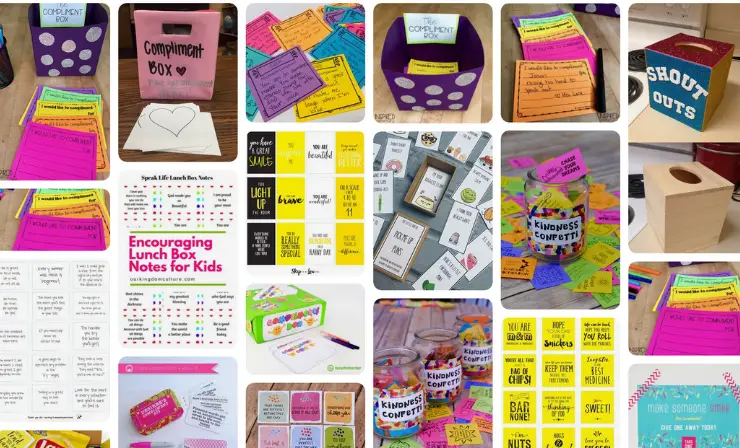
Difficulty level: Low
Cost: Low
What Does It Teach: Observational skills, positivity, and self-esteem; sharing compliments and kind words.
Sustain an ongoing exchange of commendations through the introduction of an aesthetically pleasing compliment box, seamlessly integrated as a perennial presence within the classroom setting. Within this construct, students engage in the composition of complimentary remarks upon paper slips, subsequently depositing them within the designated repository. Converging upon a pre-established juncture, educators execute the role of conduits, disbursing these expressions of approval to their respective recipients.
This systematic enactment capitalizes on the cultivation of positive interactions. The compliment box serves as a nexus wherein the act of giving recognition assumes a tangible form, fostering a culture of appreciation. The written format engenders thoughtfulness and precision in articulating commendatory observations. The subsequent dissemination of these words of praise underlines the significance attributed to acknowledging and amplifying individual virtues.
The cyclical nature of this process perpetuates a continuous loop of affirmations, engendering an environment where mutual respect and constructive validation form the crux of interpersonal dynamics. In this configuration, the compliment box transcends its tangible presence to embody a conduit for the perpetuation of goodwill, thereby consolidating its role as a conduit for the nurturing of positive ethos.
Dive into a video presentation on how to establish a compliment box for fostering a culture of appreciation:
5. Kindness Jar
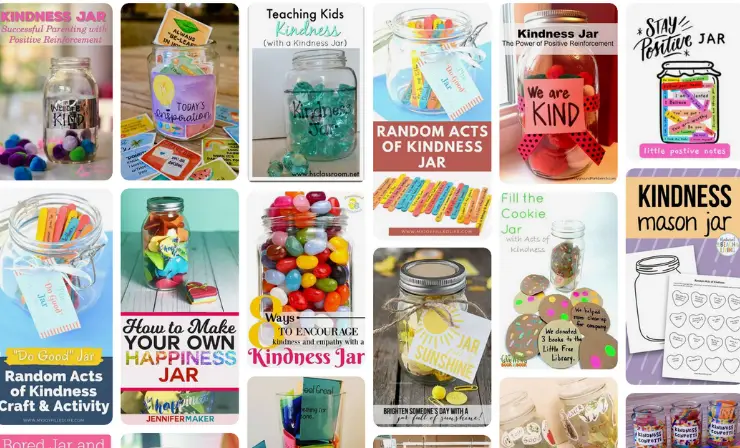
Difficulty level: Low
Cost: Low
What Does It Teach: Gratitude, recognition, and intentionality; collecting and reading acts of kindness.
Students can visually record instances of kindness directed towards them through the utilization of a kindness jar. Employ colored pompoms as tangible symbols, with each individual pompom signifying a distinct act of kindness received. These tokens, when deposited, contribute to the gradual replenishment of the vessel. The cumulative effect of this action gradually populates the container, representing the accrual of affirmative interactions. This tactile method of representation encourages a heightened awareness of the benevolent gestures extended within their surroundings. As the jar progressively fills, students encounter a tangible manifestation of the goodwill they’ve encountered, cultivating an appreciation for the collective kindness inherent in their environment.
Uncover a video tutorial on setting up a kindness jar to encourage thoughtful gestures
6. Tic-Tac-Toe
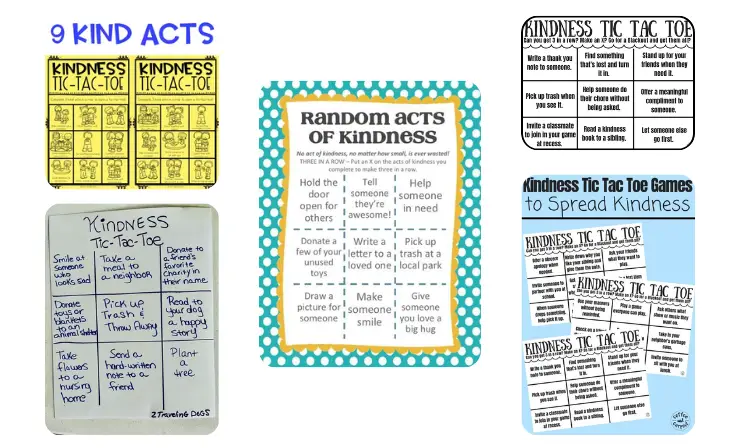
Difficulty level: Low
Cost: Low
What Does It Teach: Strategy, sportsmanship, and decision-making; playing a kindness-themed game.
Facilitate the engagement of elementary students in the cultivation of kindness within the realm of peer interactions, a pursuit actualized through a collaborative game structure. By articulating expressions of gratitude directed at their fellow classmates, participants actively embody the ethos of benevolence. This endeavor further adopts a competitive facet, wherein teams vie in the spirit of camaraderie. The culmination of this interaction yields a twofold gratification—an augmentation of enjoyment experienced during the contest and the nurturing of a sense of contentment as a consequence of the kindness conveyed.
Additionally, the strategic employment of a teaching assistant effectively diversifies the initiative. In such cases, parallel instances of the game unfold concurrently, thereby orchestrating a more expansive diffusion of student participation. This logistical arrangement enhances the interactive aspect, nurturing an inclusive environment where the ethos of kindness is widely propagated. As students articulate their gratitude and compete in unison, the activity resonates as a subtle yet impactful tool for character development and fostering positive social dynamics.
Witness a video discussion on integrating kindness into games like Tic-Tac-Toe for playful learning:
7. Fortune Teller
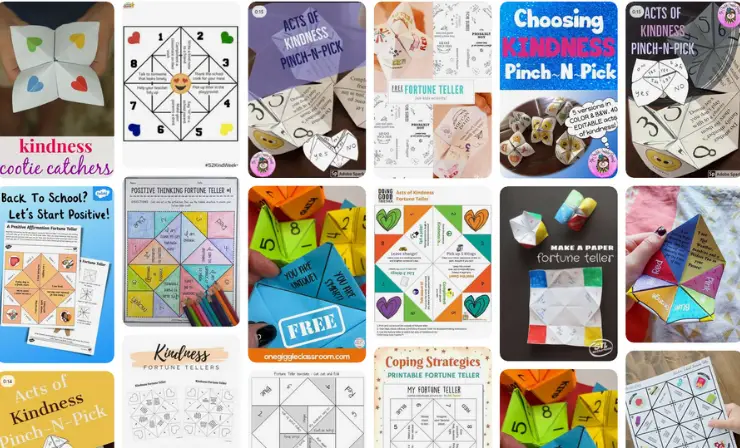
Difficulty level: Low
Cost: Low
What Does It Teach: Creativity, engagement, and communication; generating kind messages in an interactive format.
In lieu of prognosticating the future, students engage in the creation of paper fortune tellers, a pursuit yielding a sequence of kindness-oriented actions. This engaging approach amalgamates the art of origami with the cultivation of benevolence, fostering an innovative interplay between creative expression and ethical engagement. The process culminates in the crafting of the paper fortune tellers, configured to unveil successive kind actions upon interaction.
The orchestrated construction of these devices seamlessly melds manual dexterity with intentionality. As students craft the fortune tellers, they bridge creative involvement with the anticipation of subsequent acts. The unfolding of each act introduces a sense of intrigue and curiosity, subtly challenging students to embrace a trail of kindness.
The amalgamation of craftsmanship and benevolence introduces an inventive twist to the conventional notion of fortune telling. The paper fortune tellers operate as tangible vessels of goodwill, encapsulating a cyclic journey of creation, interaction, and kindness. By navigating the successive layers, students acquaint themselves with diverse kindness acts, potentially reshaping their outlook and cultivating a proactive orientation toward benevolence.
Experience a video walkthrough on creating a fortune teller for acts of kindness:
8. Kindness Stones
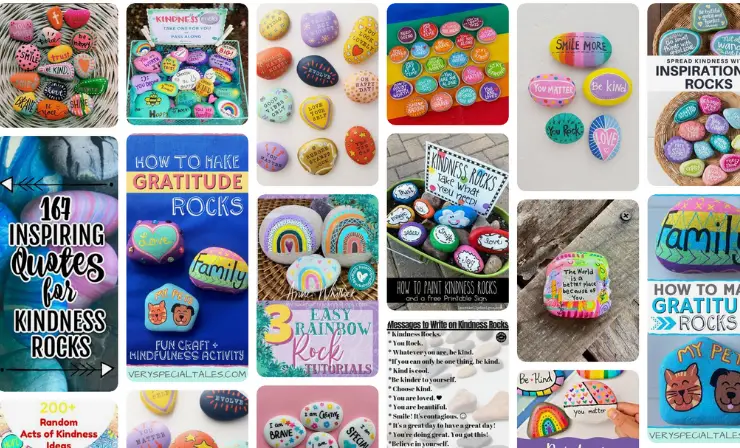
Difficulty level: Low
Cost: Medium
What Does It Teach: Creativity, mindfulness, and generosity; painting or sharing decorated stones with kind words.
Students can engage their design aptitude by inscribing benevolent expressions onto stones, subsequently adorning them in a personalized manner. This creative process not only honours artistic acumen but also enlivens the stones as tangible repositories of goodwill. Following this artistic endeavor, students proceed to strategically place these adorned stones in locations where they envisage their discovery by others. The act is driven by the intention of brightening someone’s day upon encountering these unexpected tokens of kindness.
This activity encompasses multiple layers of engagement. Initially, the process of crafting the stones involves the fusion of language and art, fostering an imaginative alliance. The act of conceiving kind words not only exemplifies the value of verbal kindness but also introduces a tactile component through the stones. Subsequent to the artistic embellishment, the act of scattering these tokens becomes a conduit for initiating micro-ripple effects of positivity within the community.
Through this intervention, students bridge their creativity with an embodied gesture of benevolence. The recipient, upon stumbling upon these artifacts, experiences a surge of positivity, directly attributed to the kindness initiated by the students. Consequently, the endeavor unifies both creative and compassionate dimensions, affirming that a small artistic intervention can potentially resonate profoundly in the domain of human connections.
Delve into a video tutorial highlighting the significance ofkindness stones and how they can spread goodwill
9. Kindness Gift
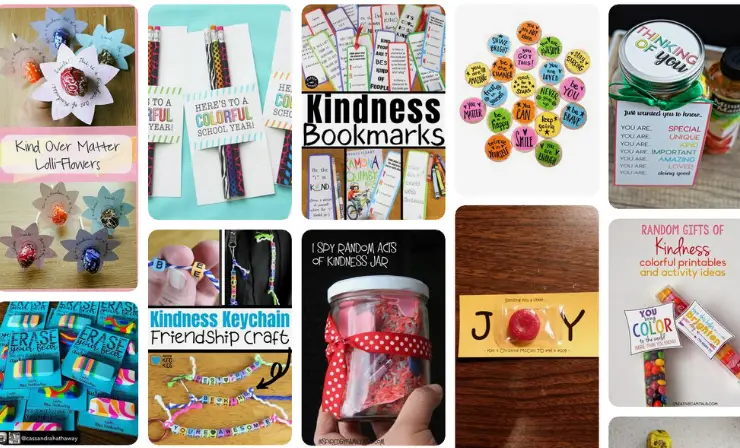
Difficulty level: Low
Cost: Medium
What Does It Teach: Creativity, thoughtfulness, and giving; crafting or giving tokens of kindness.
Students manifest acts of kindness through the formulation of a gift box tailored for an individual of significance within their lives. This undertaking encompasses the amalgamation of crafting endeavors or the assembly of meaningful items, all intended to communicate the sentiment of appreciation to the intended recipient. The creative gesture acquires significance as it translates sentiments into tangible manifestations of goodwill.
By initiating this activity, students not only cultivate empathy but also actively engage in the process of tailoring a gesture aligned with the recipient’s individuality. The act bridges intentionality with materiality, wherein the items included reflect an understanding of the recipient’s preferences and interests. This intersection elevates the action from a conventional gift exchange to a more profound demonstration of thoughtfulness.
The action of presenting the gift box denotes an articulate expression of gratitude. Through this medium, students communicate their recognition of the recipient’s value, evoking a reciprocal appreciation. The act’s significance extends beyond the exchange, resonating as a testament to the fostering of genuine human connections. In essence, the initiative radiates as a holistic embodiment of kindness, rooted in understanding, creativity, and heartfelt expression.
Learn from a video demonstration on assembling a kindness gift, enhancing giving and empathy:
10. Kindness Oath
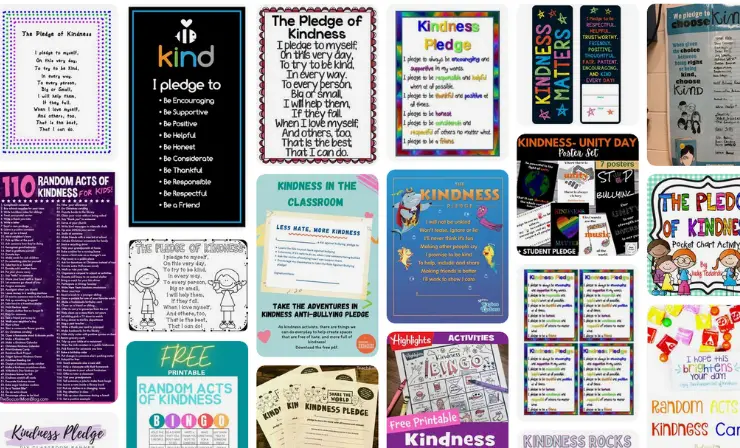
Difficulty level: Low
Cost: Low
What Does It Teach: Commitment, responsibility, and values; pledging to engage in acts of kindness.
Students assume individual agency in formulating a personalized commitment by composing an oath that outlines their intentional pursuit of kindness. This endeavor bolsters not only introspection but also the cultivation of self-accountability in relation to kindness-oriented behaviors. Furthermore, the collective classroom entity partakes in the creation of a kindness pledge, a unified enumeration of specific actions that each student pledges to undertake for the betterment of the classroom milieu.
The crafting of personal oaths delves into the internalization of kindness as a guiding principle, as students delineate behaviors they genuinely aspire to adopt. This introspective exercise encourages self-reflection, fostering the transformation of benevolence from a vague concept into a concrete intention. Simultaneously, the collaborative formation of a classroom-wide kindness pledge accentuates the collective aspect of cultivating a congenial atmosphere.
The pledge’s compilation encapsulates a shared commitment to a harmonious classroom ambiance. By assigning specific actions to each student, it amalgamates diverse facets of kindness to holistically craft an environment characterized by mutual respect and empathy. The pledge transcends the realm of verbalized aspiration, metamorphosing into a tangible guidepost for behavior and interaction, consequently nurturing an ethos of collective benevolence.
Here’s a video about preschool sharing a kindness pledge, embracing the spirit of empathy from an early age:
11. Kindness Break
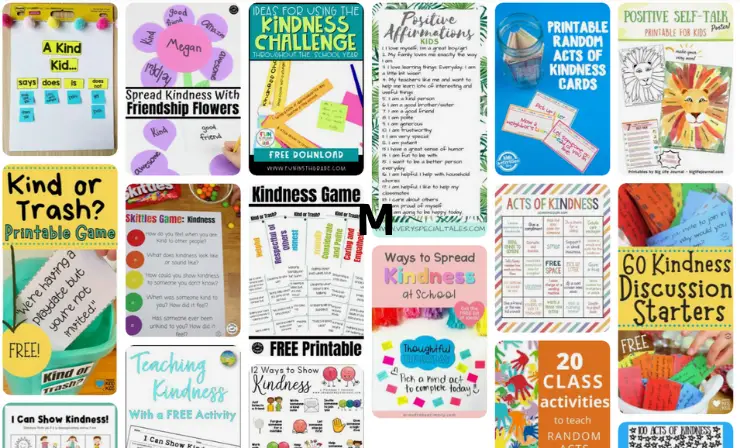
Difficulty level: Low
Cost: Free
What Does It Teach: Mindfulness, self-care, and stress reduction; taking a short break for self-kindness.
If additional time permits, an extended interval can be dedicated to a comprehensive lesson centered on kindness. A valuable resource in this regard is a video presentation that encapsulates an all-encompassing lesson plan, designed to effectively augment instances of unpremeditated benevolence within the classroom environment.
This video-based instructional approach encapsulates the requisite components for fostering a culture of kindness. The integration of diverse elements within the lesson plan cohesively contributes to the overarching objective of promoting spontaneous acts of kindness. The auditory and visual dimensions of the video medium enhance the lesson’s engagement potential, catering to varied learning styles.
Explore a video presentation on the benefits of incorporating kindness breaks into daily routines:
12. Class Brainstorm
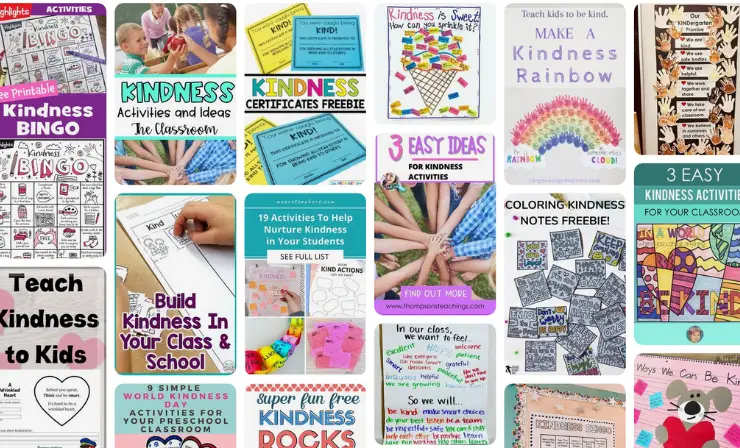
Difficulty level: Low
Cost: Free
What Does It Teach: Collaboration, communication, and inclusivity; generating and sharing kindness ideas.
Foster a collective endeavor within the student cohort, culminating in the communal deliberation on the attributes encapsulating kindness and the methods of demonstrating benevolence to others. Beyond instigating discourse centered on kindness, this collective introspection facilitates collaborative interaction, honing skills of effective communication and the articulation of responses to the thoughts of peers. This exercise further serves as an enduring classroom chart or anchor chart, poised to serve as a guiding reference over the course of the academic term.
The initiation of a class-wide dialogue concerning kindness entails multifaceted outcomes. The collective endeavor of defining the contours of kindness empowers students to collaborate, invoking the nuances of cooperation and interdependent thinking. Concurrently, the articulation of diverse viewpoints propels the cultivation of communication skills, exemplifying an avenue where students engage with the perspectives of others.
This collective process of constructing a visual representation, either as a chart or an anchor chart, encapsulates the essence of kindness within the classroom’s physical and intellectual domain. As an enduring artifact, it perpetuates the discourse on kindness, etching it into the educational environment as a constant reminder of the collaborative effort and shared ethos.
Participate in a video discourse on initiating a class brainstorm to collectively brainstorm kind actions:
13. Friendly Fridays
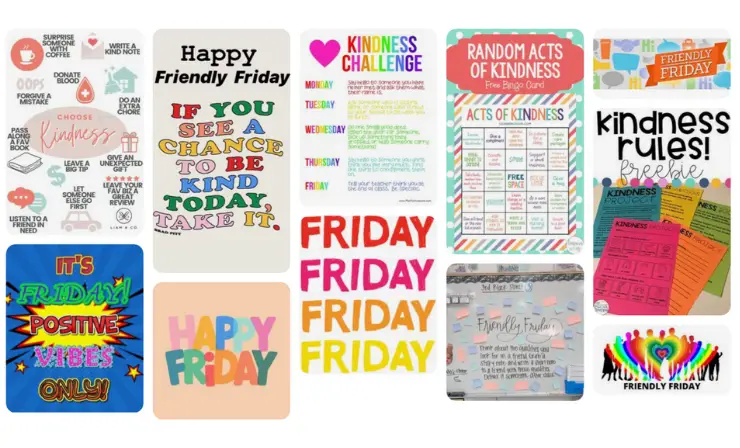
Difficulty level: Low
Cost: Free
What Does It Teach: Routine, community-building, and consistency; designating a day for extra kindness.
The conclusion of the school week, particularly Fridays, is frequently marked by heightened anticipation as students and teachers alike look forward to the impending weekend. Channeling this prevailing enthusiasm, an initiative termed “Friendly Fridays” is introduced, capitalizing on this fervor as a catalyst for the cultivation of benevolence. This structured endeavor offers students a recurring platform to undertake acts of kindness aimed at others, thereby instilling a rhythm of positive actions within their weekly routine.
The strategic deployment of the excitement permeating Fridays capitalizes on its temporal correlation with the weekend. By aligning the initiative with this collective sentiment, “Friendly Fridays” is seamlessly integrated into the students’ psyche. The cyclic nature of the exercise not only sustains the weekly engagement with kindness but also reinforces the concept of consistency and continuity.
“Friendly Fridays” operates as a conduit for the cultivation of empathy and proactive behavior. This consistent cadence encourages students to actively contemplate opportunities for kind gestures, channeling their excitement into compassionate deeds. The resultant acts, both overt and subtle, exemplify the transformation of enthusiasm into a medium for fostering a culture of kindness. This venture transcends the realm of sentimentality, resonating as a practical and ethical pursuit within the educational milieu.
Discover a video insight into the impact of Friendly Fridays, where students engage in weekly acts of kindness:
14. Kindness from A to Z

Difficulty level: Low
Cost: Low
What Does It Teach: Creativity, vocabulary, and exploration; associating kindness with different letters.
The process involves the communal reading of a designated book, followed by the allocation of a distinct letter to each student. Subsequently, students undertake the task of crafting an illustration inspired by the content encapsulated within the book’s narrative. The culmination of this creative endeavor unfolds as these illustrations are displayed within the classroom environment, where they collectively constitute a visual repository. This visual array embodies a compilation of 26 diverse expressions of kindness, intended to serve as a persistent mnemonic.
The mechanism facilitates dual functions—nurturing artistic exploration and fostering an ethos of benevolence. The combined engagement of literature and art not only enriches the students’ creative faculties but also bolsters the assimilation of kindness as a thematic construct. Furthermore, the public display of these illustrations transforms the classroom into an immersive visual medium, reinforcing the students’ exposure to varied dimensions of kindness.
This approach can also be seamlessly translated into the creation of a kindness-themed bulletin board. The expansion of the concept onto a more expansive canvas magnifies the visual impact, thereby perpetuating an environment suffused with the embodiment of kindness. This multi-faceted endeavor amalgamates artistic expression with the promotion of virtuous conduct, fashioning a tangible emblem of positive ethos within the educational sphere.
Here’s a read aloud video introducing the concept of kindness to preschoolers, fostering early understanding and empathy:
15. Be Kind to Yourself
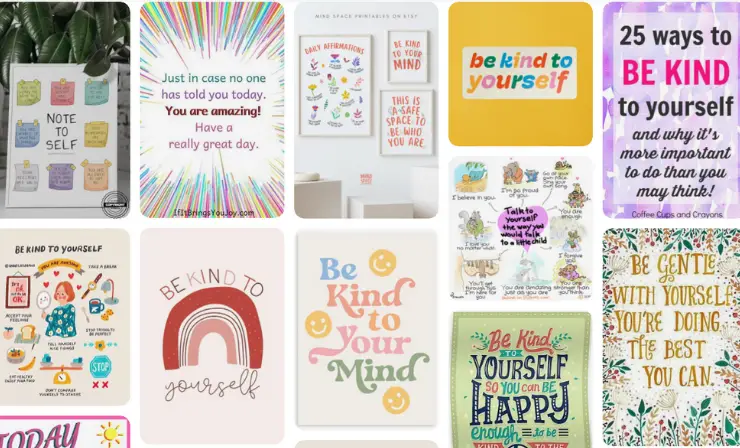
Difficulty level: Medium
Cost: Free
What Does It Teach: Self-awareness, self-compassion, and well-being; focusing on self-kindness.
The conventional perception of kindness revolves around its occurrence between individuals or groups, yet it is equally imperative to extend kindness towards oneself. The cultivation of self-kindness is a pivotal facet that warrants attention. Educators play a crucial role in imparting the means through which students can nurture a compassionate relationship with themselves.
Guiding students in the art of self-kindness is a process involving multifaceted dimensions. The pedagogical approach encompasses the cognitive and emotional spheres, facilitating self-awareness and self-compassion. Equipping students with tools to navigate self-kindness necessitates an amalgamation of psychological and practical strategies.
The cultivation of self-kindness, rather than being a mere concept, is a journey requiring cognitive and behavioral recalibration. Students are prompted to recognize the value of their well-being, infusing a sense of mindfulness into their daily routines. The process also encompasses the identification of negative self-talk and the fostering of affirming internal dialogue.
The teacher’s role transcends the academic realm, functioning as a guide in nurturing holistic well-being. By imparting the principles of self-kindness, educators facilitate the development of self-compassionate individuals who are equipped to navigate the intricate landscapes of both their internal worlds and external interactions.
Reflect on a video presentation advocating the significance of being kind to yourself as a foundation for kindness:
16. Kindness Quilt
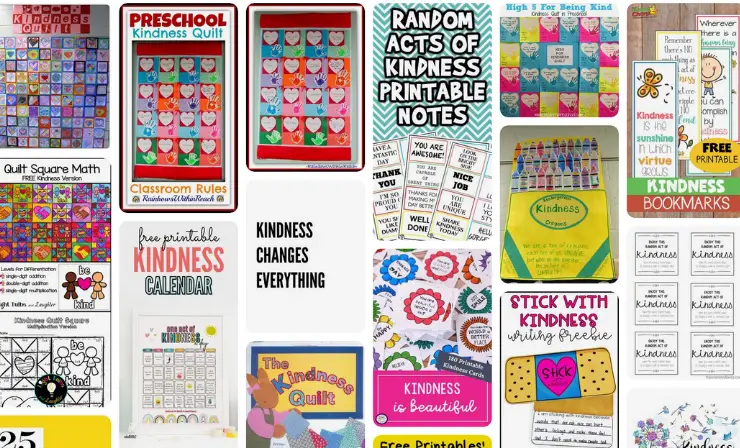
Difficulty level: Medium
Cost: Medium
What Does It Teach: Creativity, teamwork, and symbolism; contributing to a visual representation of kindness.
A quilt offers a poignant avenue to experience contentment stemming from acts of kindness. Students can harness this medium to craft individual quilts or contribute to a communal class quilt, collectively articulating the essence of kindness. By partaking in the construction of such a tangible artifact, students explore a sensorial engagement with the concepts they seek to portray. The quilt becomes a canvas where the essence of kindness is interwoven with fabric, materializing as a tangible emblem of their collective efforts. Through this creation process, students internalize the values they depict, forging a connection between the physicality of the quilt and the emotional resonance of kindness.
Witness a video guide detailing the process of crafting a kindness quilt as a visual embodiment of goodwill:
17. Science of Kindness
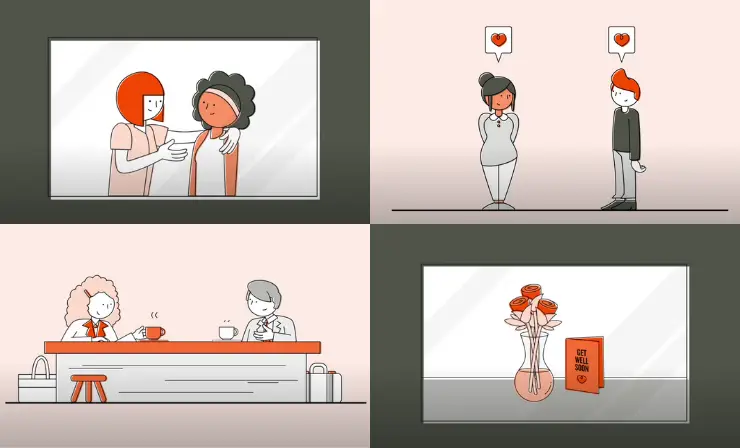
Difficulty level: Medium
Cost: Free
What Does It Teach: Critical thinking, exploration, and empathy; understanding the psychological and physiological effects of kindness.
Acts of kindness, whether initiated or received, exert a demonstrable influence upon the brain, eliciting positive responses and contributing to a sense of happiness. The dynamics at play within the brain in the presence of kindness form the focal point of a video presentation. The visual exploration delves into the neural processes that unfold during instances of kindness, either as an initiator or as a recipient.
The video’s narrative delves into the intricate interplay of neurochemicals and neural pathways underpinning the emotional and cognitive reactions to kindness. The cognitive and emotional dimensions are seamlessly intertwined within this exploration, rendering it a multi-dimensional educational tool.
Post-video engagement materializes in the form of reflection, whereby students internalize the content and relate it to their personal experiences and responses. This reflective practice nurtures self-awareness and empathy, bridging theory with the practical application within their interpersonal lives.
This educational approach capitalizes on visual and reflective components to stimulate cognitive engagement. The conceptualization of kindness as a neural trigger underscores its intrinsic link to human well-being. The cohesive narrative and post-viewing contemplation amplify the educational impact, resulting in an enriching exploration of the intricate relationship between kindness, brain functions, and emotional well-being.
18. Kindness Videos
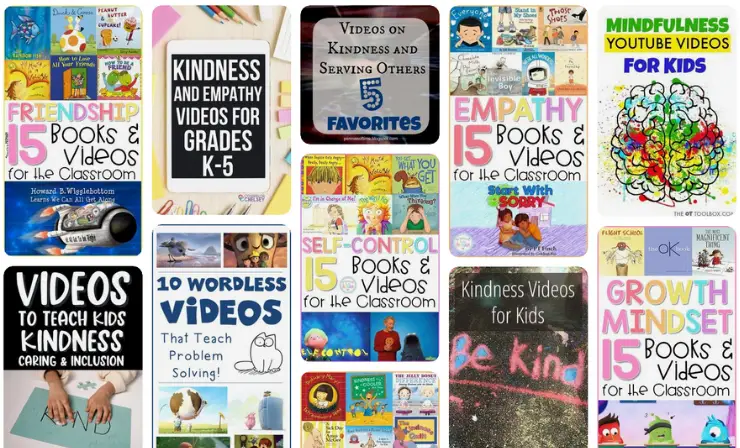
Difficulty level: Medium
Cost: Free
What Does It Teach: Empathy, and communication; watching and discussing videos on kindness.
Contained within this website is an array of videos dedicated to the theme of kindness. These videos encompass an exploration of kindness’s significance alongside strategies for its cultivation among children. The pedagogical utilization involves the discretion of educators in selecting specific videos or opting for a comprehensive viewing of the entire series. Subsequent to the viewing experience, the cultivation of intellectual engagement is realized through organized discussions centered on the insights garnered from the videos.
The educational dimension of the videos is rooted in their thematic diversity. They encapsulate a panoramic spectrum, ranging from the conceptualization of kindness to its practical enactment within various contexts. The selection process allows teachers to align the videos with specific learning objectives or the unique needs of the student cohort.
Post-viewing discourse facilitates cognitive assimilation. Participants partake in the articulation of thoughts, impressions, and learnings gleaned from the videos. This platform nurtures the development of communication skills, analytical thinking, and the capacity to extrapolate knowledge from audiovisual stimuli.
The incorporation of these videos as an instructional resource seamlessly converges visual learning with thoughtful deliberation. The post-viewing dialogues effectively bridge theory with reflection, fostering a multi-dimensional approach to cultivating the ethos of kindness within the educational milieu.
Here’s a kindness-focused video designed to engage and inspire your students, illustrating the power of compassion in action:
19. Wheel of Kindness
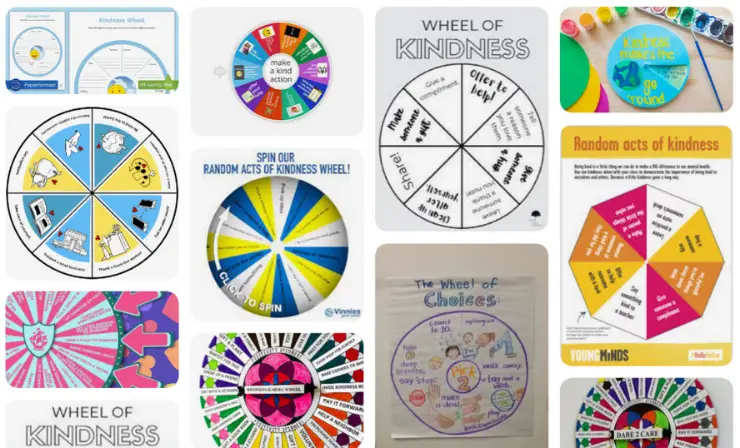
Difficulty level: High
Cost: Medium
What Does It Teach: Engagement, decision-making, and spontaneity; spinning a wheel to determine a kind action.
Children have the opportunity to craft an exclusive “Wheel of Kindness” using this spinner design. The process entails cutting out the designated template, embellishing it in a personalized manner, and subsequently configuring it into a functional spinner apparatus. The ensuing dynamic unfolds as students partake in the act of spinning, resulting in the selection of a specific kindness-oriented endeavor to undertake.
The creation phase stimulates artistic engagement and lends the apparatus an individualized touch. The very act of constructing the spinner instills a sense of ownership and personal investment within the children. As the spinner revolves and designates a particular kind action, the engagement with randomness infuses an element of spontaneity into the enactment of kindness. This dynamic adds an unpredictably adventurous facet to the experience.
Beyond its entertainment value, the “Wheel of Kindness” bolsters the conscious cultivation of benevolence. The randomized selection of kind actions diversifies the spectrum of behaviors practiced, in turn nurturing a multifaceted understanding of kindness. This embodiment of thoughtful acts is a pivotal tool, imbued with the potential to subtly weave kindness into the daily fabric of young lives.
Experience a video showcase of the wheel of kindness, a dynamic tool for generating acts of goodwill:
20. Dance for Kindness
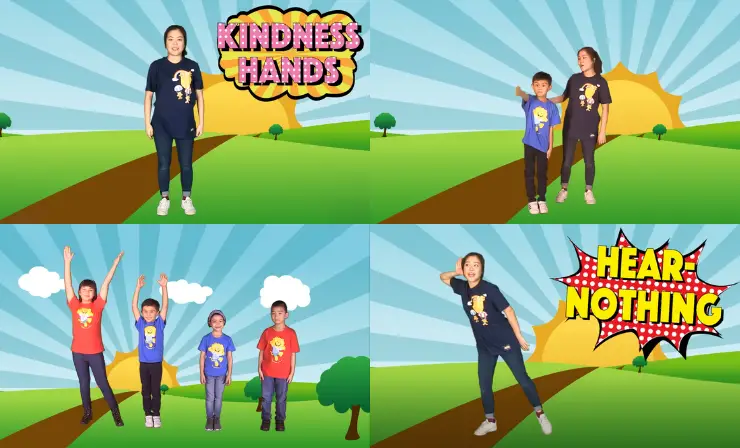
Difficulty level: Medium
Cost: Free
What Does It Teach: Expression, unity, and community involvement; dancing together for a common cause.
Within this video, an embedded song centered on kindness resonates, accompanied by a choreographed dance routine. The combination of auditory and kinesthetic elements renders this resource a dynamic avenue. Upon its presentation to children, it incites a spontaneous engagement wherein they readily embrace the song and partake in the corresponding dance. The auditory-kinesthetic convergence not only uplifts the classroom atmosphere but also introduces an enjoyable method of acquainting students with the concept of kindness.
The marriage of music and movement emerges as an effective pedagogical tool. The song’s lyrical content immerses children in the theme of kindness, employing rhythm and melody to foster an auditory connection with the concept. The dance component supplements this by channeling the theme into a physical expression, bolstering both engagement and retention.
As students internalize the song’s message and translate it into movement, they actively engage with the ethos of kindness. The integration of song and dance catalyzes a holistic sensory experience, embedding the theme within their consciousness. The collective engagement can facilitate peer bonding and create a shared memory, echoing the essence of kindness through the rhythm of music and coordinated movement.
21. Ripple Effect
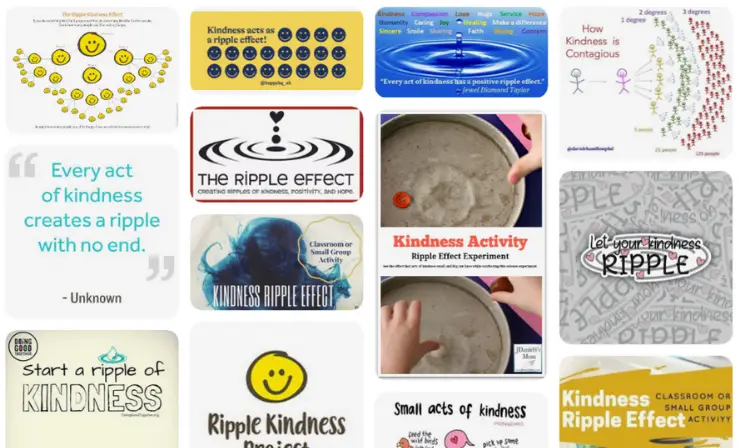
Difficulty level: High
Cost: Medium
What Does It Teach: Causality, interconnectedness, and empathy; understanding how small acts of kindness can create positive impacts.
The emergence of subsequent acts frequently follows a single act of kindness, initiating what is commonly referred to as the ripple effect. This phenomenon invites students to examine the concept firsthand through a tactile and contemplative engagement. Employing solely a receptacle containing water and a minor quantity of food coloring, this activity encourages students to immerse themselves in the exploration.
The interplay between actions and their consequences finds resonance within this endeavor. The tactile nature of dispersing food coloring within water allows students to witness the radial expansion—a physical manifestation akin to the ripple effect. This observation serves as a visual analogy to the manner in which a solitary act of kindness radiates across interactions.
Beneath the surface, this activity instigates cognitive reflection. Students are prompted to discern the broader implication, attributing the water’s dispersion to the interconnectedness of actions. The fusion of visual demonstration and cognitive contemplation augments comprehension of how a single gesture can initiate a continuum of positive consequences. This engagement amalgamates experiential observation and intellectual musing, encapsulating the essence of the ripple effect as a profound principle governing interpersonal dynamics.
Uncover a video narrative elucidating the ripple effect, highlighting the profound impact of small acts of kindness:
22. Edgar the Egg

Difficulty level: High
Cost: Medium
What Does It Teach: Engagement, creativity, and empathy; caring for a “fragile” character to learn about kindness.
Facilitate Edgar’s emotional well-being through the application of kindness. Students engage in a visual experiment where an egg submerged in water transitions from sinking to floating when placed in another container filled with water infused with sprinkles of kindness (salt). This activity offers a tangible depiction of the transformative influence of benevolence upon an individual’s disposition.
The experiment introduces a tactile and empirical dimension to the concept of kindness. Through hands-on engagement, students connect the act of sprinkling kindness with a palpable transformation, an abstraction rendered into a concrete manifestation. The correlation between the egg’s response and the infusion of kindness promotes an understanding of the intrinsic potency of benevolent actions.
As students witness the shift from sinking to floating, they assimilate the metaphorical parallel that kindness possesses in altering a person’s emotional state. The practical demonstration accentuates the tangible outcomes of kindness, while fostering empathy by encouraging students to empathize with Edgar’s experience. The experiential aspect elevates the lesson from mere conceptual comprehension to embodied understanding, nurturing the capacity to wield kindness as an instrument of positive transformation.
Useful Resources
Conclusion
For those seeking to commemorate World Kindness Day or Random Acts of Kindness Day, a selection of Elementary school kindness activities awaits. These activities not only engage students but also cultivate vital social-emotional skills with enduring real-life applications. By aligning these activities with such occasions, educators not only enhance the educational experience but also instill values that transcend the classroom, contributing to holistic student development.
- Overview of 22 Low-Code Agencies for MVP, Web, or Mobile App Development - October 23, 2024
- Tips to Inspire Your Young Child to Pursue a Career in Nursing - July 24, 2024
- How Parents Can Advocate for Their Children’s Journey into Forensic Nursing - July 24, 2024
